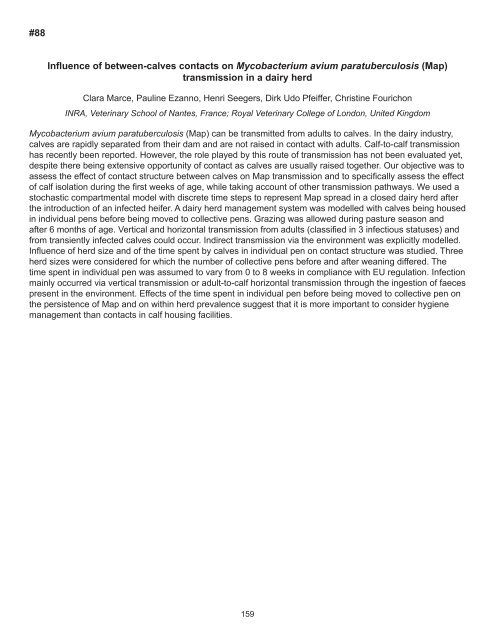Proceedings of the 10th International Colloquium on Paratuberculosis
Proceedings of the 10th International Colloquium on Paratuberculosis
Proceedings of the 10th International Colloquium on Paratuberculosis
You also want an ePaper? Increase the reach of your titles
YUMPU automatically turns print PDFs into web optimized ePapers that Google loves.
#88<br />
Influence <str<strong>on</strong>g>of</str<strong>on</strong>g> between-calves c<strong>on</strong>tacts <strong>on</strong> Mycobacterium avium paratuberculosis (Map)<br />
transmissi<strong>on</strong> in a dairy herd<br />
Clara Marce, Pauline Ezanno, Henri Seegers, Dirk Udo Pfeiffer, Christine Fourich<strong>on</strong><br />
INRA, Veterinary School <str<strong>on</strong>g>of</str<strong>on</strong>g> Nantes, France; Royal Veterinary College <str<strong>on</strong>g>of</str<strong>on</strong>g> L<strong>on</strong>d<strong>on</strong>, United Kingdom<br />
Mycobacterium avium paratuberculosis (Map) can be transmitted from adults to calves. In <str<strong>on</strong>g>the</str<strong>on</strong>g> dairy industry,<br />
calves are rapidly separated from <str<strong>on</strong>g>the</str<strong>on</strong>g>ir dam and are not raised in c<strong>on</strong>tact with adults. Calf-to-calf transmissi<strong>on</strong><br />
has recently been reported. However, <str<strong>on</strong>g>the</str<strong>on</strong>g> role played by this route <str<strong>on</strong>g>of</str<strong>on</strong>g> transmissi<strong>on</strong> has not been evaluated yet,<br />
despite <str<strong>on</strong>g>the</str<strong>on</strong>g>re being extensive opportunity <str<strong>on</strong>g>of</str<strong>on</strong>g> c<strong>on</strong>tact as calves are usually raised toge<str<strong>on</strong>g>the</str<strong>on</strong>g>r. Our objective was to<br />
assess <str<strong>on</strong>g>the</str<strong>on</strong>g> effect <str<strong>on</strong>g>of</str<strong>on</strong>g> c<strong>on</strong>tact structure between calves <strong>on</strong> Map transmissi<strong>on</strong> and to specifically assess <str<strong>on</strong>g>the</str<strong>on</strong>g> effect<br />
<str<strong>on</strong>g>of</str<strong>on</strong>g> calf isolati<strong>on</strong> during <str<strong>on</strong>g>the</str<strong>on</strong>g> first weeks <str<strong>on</strong>g>of</str<strong>on</strong>g> age, while taking account <str<strong>on</strong>g>of</str<strong>on</strong>g> o<str<strong>on</strong>g>the</str<strong>on</strong>g>r transmissi<strong>on</strong> pathways. We used a<br />
stochastic compartmental model with discrete time steps to represent Map spread in a closed dairy herd after<br />
<str<strong>on</strong>g>the</str<strong>on</strong>g> introducti<strong>on</strong> <str<strong>on</strong>g>of</str<strong>on</strong>g> an infected heifer. A dairy herd management system was modelled with calves being housed<br />
in individual pens before being moved to collective pens. Grazing was allowed during pasture seas<strong>on</strong> and<br />
after 6 m<strong>on</strong>ths <str<strong>on</strong>g>of</str<strong>on</strong>g> age. Vertical and horiz<strong>on</strong>tal transmissi<strong>on</strong> from adults (classified in 3 infectious statuses) and<br />
from transiently infected calves could occur. Indirect transmissi<strong>on</strong> via <str<strong>on</strong>g>the</str<strong>on</strong>g> envir<strong>on</strong>ment was explicitly modelled.<br />
Influence <str<strong>on</strong>g>of</str<strong>on</strong>g> herd size and <str<strong>on</strong>g>of</str<strong>on</strong>g> <str<strong>on</strong>g>the</str<strong>on</strong>g> time spent by calves in individual pen <strong>on</strong> c<strong>on</strong>tact structure was studied. Three<br />
herd sizes were c<strong>on</strong>sidered for which <str<strong>on</strong>g>the</str<strong>on</strong>g> number <str<strong>on</strong>g>of</str<strong>on</strong>g> collective pens before and after weaning differed. The<br />
time spent in individual pen was assumed to vary from 0 to 8 weeks in compliance with EU regulati<strong>on</strong>. Infecti<strong>on</strong><br />
mainly occurred via vertical transmissi<strong>on</strong> or adult-to-calf horiz<strong>on</strong>tal transmissi<strong>on</strong> through <str<strong>on</strong>g>the</str<strong>on</strong>g> ingesti<strong>on</strong> <str<strong>on</strong>g>of</str<strong>on</strong>g> faeces<br />
present in <str<strong>on</strong>g>the</str<strong>on</strong>g> envir<strong>on</strong>ment. Effects <str<strong>on</strong>g>of</str<strong>on</strong>g> <str<strong>on</strong>g>the</str<strong>on</strong>g> time spent in individual pen before being moved to collective pen <strong>on</strong><br />
<str<strong>on</strong>g>the</str<strong>on</strong>g> persistence <str<strong>on</strong>g>of</str<strong>on</strong>g> Map and <strong>on</strong> within herd prevalence suggest that it is more important to c<strong>on</strong>sider hygiene<br />
management than c<strong>on</strong>tacts in calf housing facilities.<br />
159






